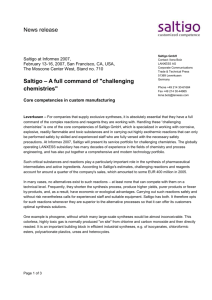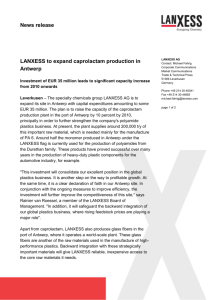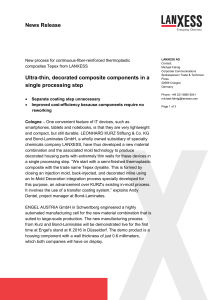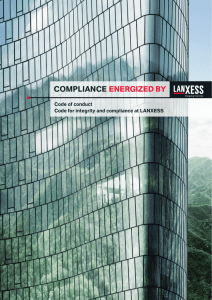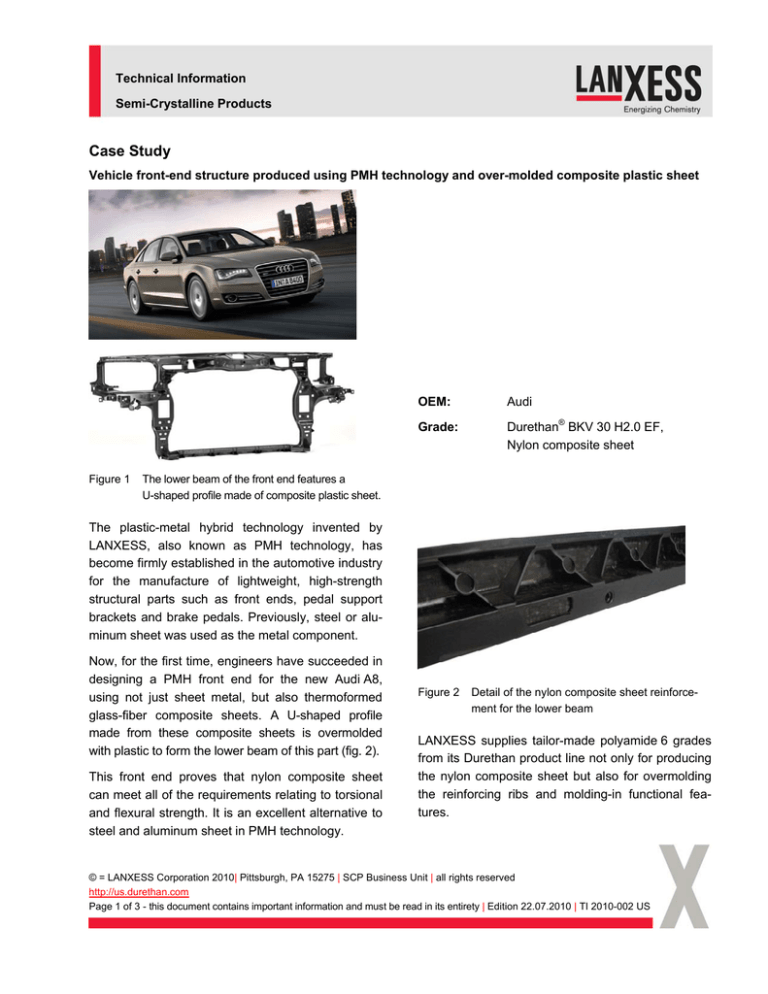
Technical Information
Semi-Crystalline Products
Case Study
Vehicle front-end structure produced using PMH technology and over-molded composite plastic sheet
Figure 1
OEM:
Audi
Grade:
Durethan® BKV 30 H2.0 EF,
Nylon composite sheet
Figure 2
Detail of the nylon composite sheet reinforcement for the lower beam
The lower beam of the front end features a
U-shaped profile made of composite plastic sheet.
The plastic-metal hybrid technology invented by
LANXESS, also known as PMH technology, has
become firmly established in the automotive industry
for the manufacture of lightweight, high-strength
structural parts such as front ends, pedal support
brackets and brake pedals. Previously, steel or aluminum sheet was used as the metal component.
Now, for the first time, engineers have succeeded in
designing a PMH front end for the new Audi A8,
using not just sheet metal, but also thermoformed
glass-fiber composite sheets. A U-shaped profile
made from these composite sheets is overmolded
with plastic to form the lower beam of this part (fig. 2).
This front end proves that nylon composite sheet
can meet all of the requirements relating to torsional
and flexural strength. It is an excellent alternative to
steel and aluminum sheet in PMH technology.
LANXESS supplies tailor-made polyamide 6 grades
from its Durethan product line not only for producing
the nylon composite sheet but also for overmolding
the reinforcing ribs and molding-in functional features.
© = LANXESS Corporation 2010| Pittsburgh, PA 15275 | SCP Business Unit | all rights reserved
http://us.durethan.com
Page 1 of 3 - this document contains important information and must be read in its entirety | Edition 22.07.2010 | TI 2010-002 US
The nylon composite sheet is produced by BondLaminates GmbH in Brilon, Germany.
These composite sheets are produced using
thermoplastics (in this case with polyamide 6 as the
matrix) reinforced with continuous fibers. Because of
their high strength and stiffness combined with low
density, they make outstanding lightweight construction materials. To manufacture a hybrid component,
the nylon composite sheet is first heated, formed
and trimmed. The part is then placed in an injection
molding tool and strengthened with ribbing or reinforcements made, for example, of polyamide 6, thus
forming a material bond. Together with a number of
its partners, LANXESS is currently working on transferring the previously separate forming step into the
injection mold, so that the forming and injection
processes can be carried out in a single operation
for greater cost-effectiveness and productivity.
The nylon composite sheet reinforcement for the
lower beam (aluminum sheet is used for the upper
beam) is just 1.0 mm thick. When the car is out on
the road, the part is subjected to considerable loads
because the lower beam carries, among other
things, pedestrian protection components, the
bumper, the underbody protection and the cooling
module attachments. Despite this, it was possible to
design the U-shaped composite profile thinner than
with aluminum sheet.
Easy-flow Durethan® BKV 30 EF (polyamide 6) reinforced with 30 percent glass fibers is used to injection mold the hybrid front end. It can be processed
with injection pressures that are up to 40 percent
lower than with comparable standard grades of
polyamide 6. This means less mold wear and therefore lower mold maintenance costs. Apart from that,
walls can be made thinner, and finely structured
geometries can be reproduced more accurately.
Additional savings come from lower injection temperatures (less energy consumption, faster cycle
time). Furthermore, fewer gates are needed, which
helps to achieve uniform orientation of the glass
fibers and thus minimize shrinkage and warpage.
As with earlier PMH front ends, many functions are
integrated into the front end of the Audi A8, which
considerably simplifies subsequent assembly and
the logistical operations connected with it. Such
functions include attachment points for the radiator,
crash sensor, oil cooler air scoop, headlamps and
headlamp bezels. Threaded bushings and the connections to the fender carrier and the bumper skin
are also integrated.
LANXESS provided its partners with comprehensive
support in developing the front end. For example,
mold filling analyses were carried out to minimize
component warpage and achieve optimum filling of
the mold. Furthermore, the torsional and flexural
behavior of the nylon composite sheet carrier were
tested to validate the simulation of its crash behavior. When simulating the design of the part, it was a
big advantage that LANXESS already had the mechanical data for both the nylon composite sheet
and the easy-flow polyamide 6 that is used as the
other component in the injection molding process.
Finally, the company's experts were also able to give
assistance with tool try-outs and production start-up.
© = LANXESS Corporation 2010| Pittsburgh, PA 15275 | SCP Business Unit | all rights reserved
http://us.durethan.com
Page 2 of 3 - this document contains important information and must be read in its entirety | Edition 22.07.2010 | TI 2010-002 US
®
®
Durethan and Pocan are registered trademarks of LANXESS Deutschland GmbH
The manner in which you use and the purpose to which you put and utilize our products, technical assistance and information (whether verbal, written or by way
of production evaluations), including any suggested formulations and recommendations, are beyond our control. Therefore, it is imperative that you test our
products, technical assistance and information to determine to your own satisfaction whether they are suitable for your intended uses and applications. This
application-specific analysis must at least include testing to determine suitability from a technical as well as health, safety and environmental standpoint. Such
testing has not necessarily been done by us. Unless we otherwise agree in writing, all products are sold strictly pursuant to the terms of our standard conditions
of sale. All information and technical assistance is given without warranty or guarantee, and is subject to change without notice. It is expressly understood and
agreed that you assume and hereby expressly release us from all liability, in tort, contract or otherwise, incurred in connection with the use of our products,
technical assistance and information. Any statement or recommendation not contained herein is unauthorized and shall not bind us. Nothing herein shall be
construed as a recommendation to use any product in conflict with patents covering any material or its use. No license is implied or in fact granted under the
claims of any patent.
Developmental Product
Any product designated as a developmental product is not considered part of the LANXESS Corporation line of standard commercial products. Complete commercialization and continued supply are not assured. The purchaser/user agrees that LANXESS Corporation reserves the right to discontinue this product
without prior notice.
Typical Properties
Property data is provided as general information only. Property values are approximate and are not part of the product specifications.
Health and Safety
Appropriate literature has been assembled which provides information concerning the health and safety precautions that must be observed when handling
LANXESS products mentioned in this publication. Before working with these products, you must read and become familiar with the available information on their
hazards, proper use, and handling. This cannot be overemphasized. Information is available in several forms, e.g., material safety data sheets (MSDS) and
product labels. Consult your LANXESS Corporation representative or contact the Product Safety and Regulatory Affairs Department at LANXESS. For materials
that are not LANXESS products, appropriate industrial hygiene and other safety precautions recommended by their manufacturer(s) must be followed.
Regulatory Compliance
Some of the end uses of the products described in this brochure must comply with applicable regulations, such as the FDA, NSF, USDA and CPSC. If you have
any questions on the regulatory status of any LANXESS engineering thermoplastic, consult your LANXESS Corporation representative or contact the LANXESS
Regulatory Affairs Manager.
Regrind
Where end-use requirements permit, regrind may be used with virgin material in quantities specified in individual product information bulletins, provided that the
material is kept free of contamination and is properly dried (see maximum permissible quantities and drying conditions in product information bulletins). Any
regrind used must be generated from properly molded/extruded parts, sprues, runners, trimmings and/or film. All regrind used must be clean, uncontaminated,
and thoroughly blended with virgin resin prior to drying and processing. Under no circumstances should degraded, discolored, or contaminated material be used
for regrind. Materials of this type should be discarded. Improperly mixed and/or dried regrind may diminish the desired properties of a particular LANXESS
product. It is critical that you test finished parts produced with any amount of regrind to ensure that your end-use performance requirements are fully met. Regulatory or testing organizations (e.g., UL) may have specific requirements limiting the allowable amount of regrind. Because third party regrind generally does not
have a traceable heat history or offer any assurance that proper temperatures, conditions, and/or materials were used in processing, extreme caution must be
exercised in buying and using regrind from third parties. The use of regrind material should be avoided entirely in those applications where resin properties
equivalent to virgin material are required, including but not limited to color quality, impact strength, resin purity, and/or load-bearing performance.
Note:
The information contained in this publication is current as of July, 2010. Please contact LANXESS Corporation to determine if this publication has been revised.
© = LANXESS Corporation 2010| Pittsburgh, PA 15275 | SCP Business Unit | all rights reserved
http://us.durethan.com
Page 3 of 3 - this document contains important information and must be read in its entirety | Edition 22.07.2010 | TI 2010-002 US

